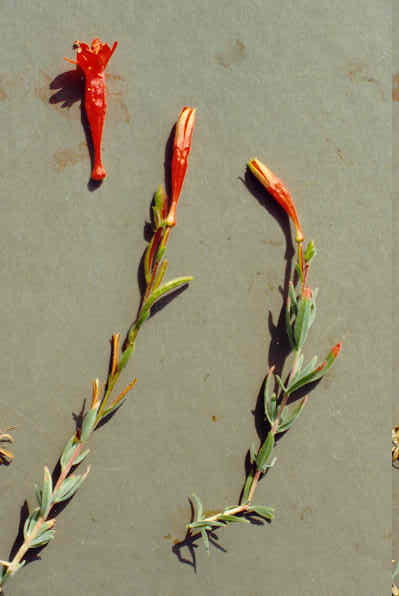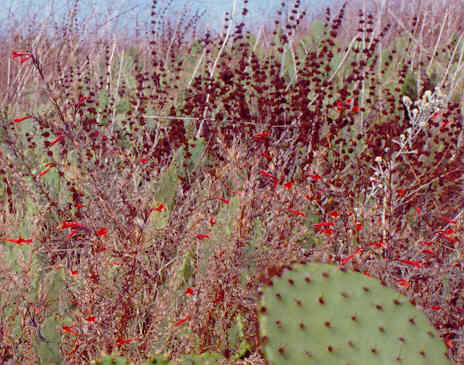
Epilobium canum (E.Greene) Raven ssp. canum
= Epilobium canum ssp. angustifolium
=Zauschneria californica ssp. californica
 |
Epilobium canum (E.Greene) Raven ssp. canum= Epilobium canum ssp. angustifolium=Zauschneria californica ssp. californica
Onagraceae (Evening-Primrose Family)NativeCalifornia Fuchsia |
September Photo
Plant Characteristics:
Perennial, suffrutescent at base, the stems 3-9 dm. long; lvs. moderately
fasciculate, linear, densely tomentose-canescent, 0.5-4 cm. long, 2-3.5 mm.
wide, the lower often opposite or subopposite, the upper usually alternate,
lateral veins usually not evident; fls. largely 3-4 cm. long; fl. tube largely
2-3 cm. long; sepals erect, lanceolate, 8-10 mm. long, scarlet; petals 4,
2-cleft, scarlet, 8-15 mm. long; stamens 8, well exserted; style and stigma
surpassing stamens; ovary 4-loculed; caps. sessile or short-pedicelled, linear,
4-angled, 8 nerved, with a short beak, often curved, variously pubescent, 1.5-2
cm. long; seeds many, 1.5 mm. long.
Habitat:
Dry slopes below 2000 ft.; Coastal Sage Scrub, Chaparral; San Diego Co.
to Monterey Co.; Catalina Id. Aug.-
Oct.
Name:
Named for Dr. Johann Baptista Josef Zauschner
(1737-1799) the University of Prague. Zauschner
was a professor of medicine and botany at the University of Prague.
(Dale 144). Californica,
of California. (Bailey 12).
Epilobium, Greek, epi-,
upon, and lobon, a caps. (Munz, Flora
So. Calif. 605). Latin, canum,
whitish-gray. (Simpson 89).
Latin, angust, narrow, small.
(Jaeger 19). Canum
probably refers to the tomentose-canescent leaves and angustifolium to the fact that they are narrower than in some other
species. (my comments).
General:
Rare in the study area with only one group of plants known and these in
the middle of a cactus patch on the bluff between 23rd St. and the Delhi area.
When I found the plants there was a hummingbird feeding on the nectar in
the flower tubes and when a flower tube was opened for identification, there was
an unusually large amount of nectar inside. (my comments).
California Fuchsia was called Balsamea
by the early Spanish who applied a solution of it to cuts and bruises.
It is cultivated in gardens in the east where it is known as
Hummingbird's Trumpet. It also does
very well in California gardens and is readily available at some nurseries.
((Parsons 372).
Parsons book was published in 1909.
(my comment).
Hummingbird
pollinated. (Hickman, Ed. 796).
Many plants of this species grew on the Jasmine Canyon slopes until it
was converted to homes. (John
Johnson). Leaves reportedly used as a detergent
in washing, and a dusting powder for cuts, wounds and sores on horses. Indians drank a decoction of leaves for tuberculosis, kidney
and bladder trouble, and for a cathartic. (Sweet
46). The
Karok Indians of northern California would suck the sweet nectar from the end of
the blossoms. (Campbell 138).
Text Ref:
Abrams, Vol. III 169; Hickman, Ed. 796; Munz, Flora
So. Calif. 616; Roberts 30.
Photo Ref:
Aug 83-Mar 94 # 5A,7A.
Identity: by R. De Ruff, confirmed by John Johnson.
First Found: September 1993.
Computer Ref: Plant Data 460.
Have plant specimen.
Last edit 6/11/05.
 |
September Photo